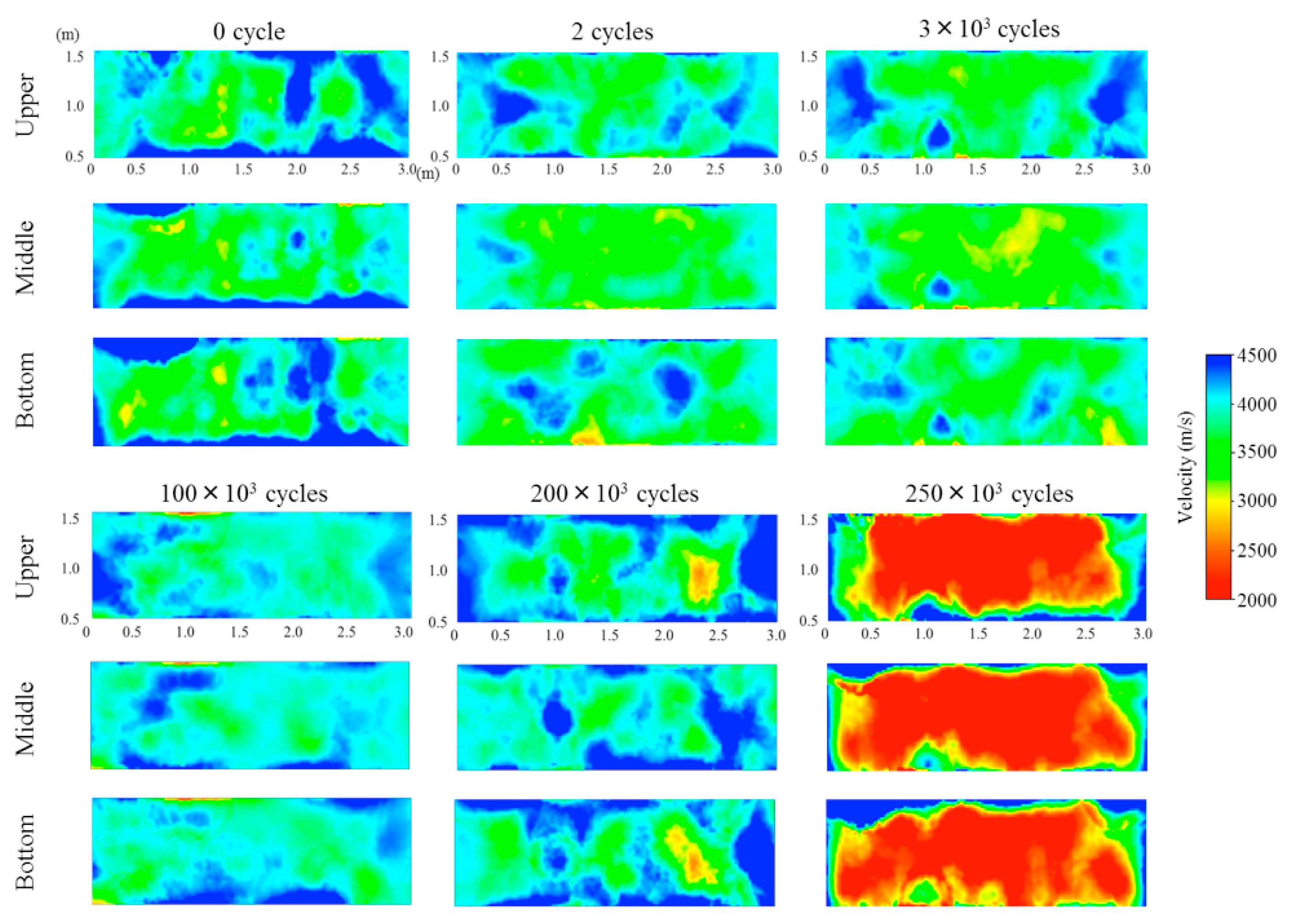Evaluation of Fracture Process in Concrete by Means of Acoustic Approaches †
Abstract
:1. Introduction
2. Measurement and Acoustic Monitoring Approaches
3. Results and Discussions
3.1. Dry Condition
3.2. Water Charged Condition
4. Conclusions
References
- The Ministry of Land, Infrastructure, Transport and Tourism: Annual report 2015 on Maintenance of Roads, Japan, 2015. Available online: http://www.mlit.go.jp/hakusyo/mlit/h26/hakusho/h27/index.html (accessed on 20 June 2018). (In Japanese).
- Shiotani, T.; Yoshimi, S.; Kamada, T.; Ohnishi, H.; Momoki, S.; Chai, H.K. Visualization of fatigue damage for concrete bridge deck with stress wave techniques. In Structural Faults and Repair 2010; CD-ROM: Edinburgh, UK, 2010. [Google Scholar]
- Shiotani, T.; Ohtsu, H.; Momoki, S.; Chai, H.K.; Onishi, H.; Kamada, T. Damage evaluation for concrete bridge deck by means of stress wave techniques. J. Bridge Eng. 2012, 17, 847–856. [Google Scholar] [CrossRef]
- Shiotani, T.; Okude, N.; Momoki, S.; Kobayashi, Y. Proposal of assessment method for infrastructures by AE tomography. In Proceedings of the 2011 National Conference on Acoustic Emission; 2011; pp. 39–42. (In Japanese). [Google Scholar]
- Kobayashi, Y.; Shiotani, T. Seismic tomography with estimation of source location for concrete structure. In Structural Faults and Repair 2012; CD-ROM: Edinburgh, UK, 2012. [Google Scholar]
- Shiotani, T.; Asaue, H.; Nishida, T.; Maeshima, T.; Tanaka, Y. Evolution of fatigue damage in wheel-loading tests evaluated by 3D elastic-wave tomography. J. Disaster Res. 2017, 12, 487–495. [Google Scholar]
- Tanaka, Y.; Maekawa, K.; Maeshima, T.; Iwaki, I.; Nishida, T.; Shiotani, T. Data assimilation for fatigue life assessment of RC bridge decks coupled with path-integral-mechanistic model and non-destructive inspection. J. Disaster Res. 2017, 12, 422–431. [Google Scholar] [CrossRef]
- Kobayashi, Y.; Shiotani, T.; Shiojiri, H. Damage identification using seismic travel time tomography on the basis of evolutional wave velocity distribution model. In Structural Faults and Repair 2006; CD-ROM: Edinburgh, UK, 2006. [Google Scholar]
- Xu, J. An effective way to validate signal arrival time in AE structural monitoring. Adv. Mater. Res. 2010, 163–167, 2471–2476. [Google Scholar] [CrossRef]
- Asaue, H.; Shiotani, T.; Hashimoto, K.; Kayano, S. Development of AE monitoring system with accelerometers for in-situ RC slab. In Proceedings of the 2017 National Conference on Acoustic Emission, Nov. 2017, Tokushima, Japan; pp. 25–28. (In Japanese).







| Max. Gravel Size (mm) | Slump (cm) | W/C (water-cement ratio) (%) | Volume Ratio of Sand s/a (%) | Air (%) | Unit Weight per 1 m3 Concrete (kg/m3) | ||||
|---|---|---|---|---|---|---|---|---|---|
| Water: W | Cement: C | Sand: S | Gravel: G | Admixture | |||||
| 20 | 12 | 64.3 | 46.6 | 4.5 | 178 | 277 | 839 | 1055 | 2.27 |
Publisher’s Note: MDPI stays neutral with regard to jurisdictional claims in published maps and institutional affiliations. |
© 2018 by the authors. Licensee MDPI, Basel, Switzerland. This article is an open access article distributed under the terms and conditions of the Creative Commons Attribution (CC BY) license (https://creativecommons.org/licenses/by/4.0/).
Share and Cite
Shiotani, T.; Asaue, H.; Hashimoto, K.; Nisahida, T. Evaluation of Fracture Process in Concrete by Means of Acoustic Approaches. Proceedings 2018, 2, 485. https://doi.org/10.3390/ICEM18-05388
Shiotani T, Asaue H, Hashimoto K, Nisahida T. Evaluation of Fracture Process in Concrete by Means of Acoustic Approaches. Proceedings. 2018; 2(8):485. https://doi.org/10.3390/ICEM18-05388
Chicago/Turabian StyleShiotani, Tomoki, Hisafumi Asaue, Katsufumi Hashimoto, and Takahiro Nisahida. 2018. "Evaluation of Fracture Process in Concrete by Means of Acoustic Approaches" Proceedings 2, no. 8: 485. https://doi.org/10.3390/ICEM18-05388





